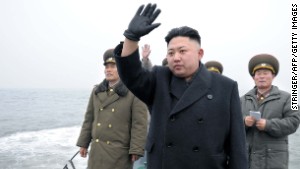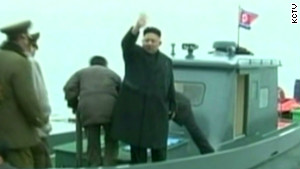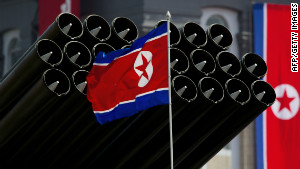
Korean War remembered
Editor's note: Seoul-based reporter Andrew Salmon is the author of Korean War histories "To the Last Round" and "Scorched Earth, Black Snow."
Seoul (CNN) -- North Korea's underground nuclear
test site, Punggye-ri, is set amid terrain appropriate for its purpose:
The mountainous, northeastern province of Hamgyong, which borders China
and Siberia, is one of the most inhospitable winter landscapes in Asia.
But this grim, forbidding
province, which is also home to the notorious Yodok labor camp, seized
the attention of the wider world half a century before Pyongyang's
nuclear tests and claims of human rights abuses made headlines.
Hamgyong witnessed
arguably the most harrowing battle fought by U.S. or British troops
since World War II, a forgotten epic that offers every ingredient for
the perfect war movie: an embattled force, towering odds, murderous
combat and treacherous weather.
Yet 60 years after the
Korean War ended, and with the number of surviving veterans rapidly
dwindling, the dramatic story of what took place at Chosin Reservoir has
so far eluded the silver screen.
"It's an amazing story," said Brian Iglesias, a former U.S. Marine, Iraq veteran and independent film producer. "It's unbelievable what they did, from both a military and a human standpoint."

Brian Iglesias served as a U.S. Marine in Iraq before turning to filmmaking.
In November 1950, a
United Nations force -- including U.S. Marines, U.S. Army units and
British Royal Marine commandos -- deployed around the strategic Chosin
Reservoir, a frozen, man-made lake high in the Hamgyong mountains that
supplied hydroelectric power to the industrial cities on the coastal
plain.
They were preparing for
what they believed would be the Korean War's final offensive. The North
Korean Army teetered on the brink of defeat; men expected to be "home
for Christmas."
What they did not know
was that China, in a brilliant feat of mass infiltration, had intervened
to support its North Korean ally, then led by Kim Il Sung, late
grandfather of current leader Kim Jong Un. As a Siberian cold front
descended over the highlands, the 30,000-strong U.N. force found itself
surrounded by eight Chinese divisions with an estimated 80,000 men.
 Jones: "You have to take him seriously"
Jones: "You have to take him seriously"
 Rodman: I'm going back to North Korea
Rodman: I'm going back to North Korea
 North Korea has new weapons program
North Korea has new weapons program
 What to make of N. Korea's newest threat
What to make of N. Korea's newest threat
Around 65 miles from the
sea, in temperatures of minus 37 degrees Celsius (minus 34 degrees
Fahrenheit) and winds of 60 knots, the British and U.S. troops' only
hope of escaping annihilation was to hack their way through massed enemy
in a fighting withdrawal.
Combat and cold claimed a
gruesome toll: Of the 15,000 U.S. troops involved, more than 3,000 died
during the 17-day struggle. But the Chinese forces paid a much greater
price forcing the allied troops from their positions -- some 60,000
replacements were required to replace men lost to firepower and cold.
The fight remains seared into veterans' memories.
"Six decades later, it's
still vivid," said Warren Wiedhahn, a retired U.S. marine. "The biggest
part of the battle in my mind was not being able to evacuate our
wounded; if they couldn't walk to keep warm, it meant almost certain
death."
It was a brutal campaign featuring a range of near-unbelievable events.
An Anglo-American force
battled 9-1 odds in an ambush in "Hellfire Valley." A marine company
somehow held off a Chinese division for five nights at a strategic pass.
Chinese soldiers blew up a bridge over a 4,000 feet deep valley,
forcing the U.S. to carry out an unprecedented operation: The
airdropping of a replacement bridge.
Lyle Bradley, a marine
fighter-bomber pilot, recalled that during one strafing run, he could
only use the cannon in one wing, as Chinese and U.S. troops were
fighting so closely.
It's an amazing story. It's unbelievable what they did, from both a military and a human standpoint.
Brian Iglesias, film producer
Brian Iglesias, film producer
On one freezing night,
embattled marines watched in awe as a single star appeared through the
clouds above their base. (That star later became the veterans' emblem.)
And as Chinese advanced and U.N. forces evacuated North Korea, a single
ship, the SS Meredith Victory, carried 14,000 desperate refugees to
safety in the South, earning the title "Ship of Miracles."
Such scenes demand cinematic treatment. In 2010, New York-based Iglesias produced an award-winning documentary, "Chosin," and has since been working on a feature film: "17 Days of Winter."
Two years ago, all looked rosy. Oscar-winners signed on: Eric Brevig (Best Effects, Visual Effects for "Total Recall") as director and Frank Pierson (Best Writing, Original Screenplay for "Dog Day Afternoon") as scriptwriter.
Then tragedy struck.
After finishing the
script, Pierson died last year, complicating revisions. The project then
hit a funding gridlock, leaving the movie in indefinite limbo.
But Iglesias remains philosophical.
"Obstacles are not
uncommon for these kinds of projects," said Iglesias. "Sometimes, it
takes a year; sometimes a decade; sometimes they never happen."
If the project never
happens, it would be par for the course for the Korean War. The conflict
left such little mark on popular culture that it is dubbed "The
Forgotten War."
"Korea was not a war like the Spanish Civil War, that intellectuals went to fight in," said Mike Breen, author of "The Koreans." "There are books and movies about it but no classics; it needs to be revisited in modern times."
Despite its near invisibility in art, the Korean War marked numerous Cold War milestones.
It was the Cold War's
first "hot war;" the first U.N. war; and the only time troops from the
"free world" advanced into a communist state, North Korea. Beijing's
shock intervention also marked the first and only battlefield clash
between the U.S. and China.
But it ended with an
inconclusive armistice, and while North Korea remains 21st century news,
the unfinished 1950-53 war lacks much of a cinematic image.
The biggest part of the battle in my mind was not being able to
evacuate our wounded; if they couldn't walk to keep warm, it meant
almost certain death.
Warren Wiedhahn, retired U.S. marine
Warren Wiedhahn, retired U.S. marine
Although Hollywood has produced numerous classics on World War II and Vietnam, perhaps the only memorable Korea-set films are "Pork Chop Hill" (1959) and "MASH" (1970). A 1952 film on Chosin, called "Retreat Hell" barely does the material justice, some believe.
"Korea is too hard to
define in Hollywood terms: They put out movies of heroism and derring-do
in World War II or arrogance and stupidity in Vietnam, and people
understand," said Don Kirk a veteran Asia-based U.S. correspondent. "We
can't do that with Korea."
"One problem with the
Korean War is generational: it happened after 'The Greatest Generation'
but before the 'Baby Boomers,'" added Mark Russell, a culture critic and
author of "Pop Goes Korea." "So for much of Hollywood, it never really happened."
But poignantly for the
war's aging veterans, this year may mark probably its last significant
commemoration: July 27, 2013 is the 60th anniversary of its end. The
anniversary has raised some hopes for a filmic treatment.
"I'm disappointed that
Hollywood hasn't done a feature film on this largely overlooked battle,"
said Wiedhahn. "It would contain drama, horror and suspense, and would
be a major attraction on the 60th anniversary of the armistice."
Since December, Iglesias and business partner Anton Sattler, another ex-Marine, have raised more than $30,000 on Kickstarter, a fundraising website, to produce a 3-D animated short on the battle and are finalizing a graphic novel.
"There is a collective
purpose with our Chosin products: Create awareness," Iglesias said. "We
decided to continue the story on different platforms."
Iglesias' passion for
Chosin is such that, with his proposed movie having just a "50-50"
chance of production, he would applaud competing projects.
"If someone else makes this movie, I'll support them," he said. "For the Korean War, there's not enough consciousness."
 10:18 PM
10:18 PM
 specialshowtoday
specialshowtoday

 Posted in:
Posted in: 

0 comments:
Post a Comment